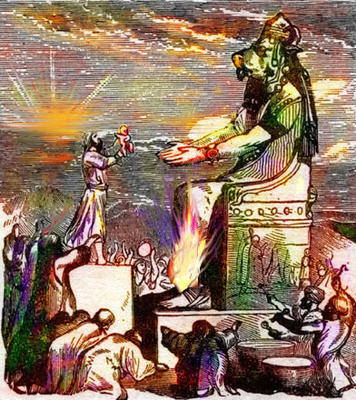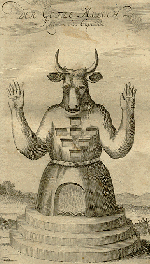Deuteronomy 18:9-14 p8
MOLECH (2 of 2)
There shall not be found among you any one thatmaketh his son or his daughter to pass through the fire. Thou shalt not let any of thy seed pass through the fire to Molech.Jamieson, Fausset, Brown Commentary
His statue was of brass, and rested on a pedestal or throne of the same metal. His head, resembling that of a calf, was adorned with a crow, and his arms were extended in the attitude of embracing those who approached him. His devotees dedicated their children to him; and when this was to be done, they heated the statue to a high pitch of intensity by a fire within, and then the infants were either shaken over the flames, or passed through the ignited arms, by way of lustration to ensure the favor of the pretended deity. The fire-worshippers asserted that all children who did not undergo this purifying process would die in infancy; and the influence of this Zabian superstition was still so extensively prevalent in the days of Moses, that the divine lawgiver judged it necessary to prohibit it by an express statute.
Matthew Henry Commentary
A law against that which was the most unnatural idolatry, causing their children to pass through the fire to Moloch, v.21. Moloch (as some think) was the idol in and by which they worshipped the sun, that great fire of the world; and therefore in the worship of it they made their own children either sacrifices to this idol, burning them to death before it, or devotees to it, causing them to pass between two fires, as some think, or to be thrown through one, to the honour of this pretended deity, imagining that the consecrating of but one of their children in this manner to Moloch would procure good fortune for all the rest of their children.
Did idolaters thus give their own children to false gods, and shall we think any thing too dear to be dedicated to, or to be parted with for, the true God? See how this sin of Israel (which they were afterwards guilty of, notwithstanding this law) is aggravated by the relation which they and their children stood in to God.
Ezekiel 16:20 Thou hast taken thy sons and thy daughters, whom thou hast borne unto me, and these thou hast sacrificed.Therefore it is here called profaning the name of their God; for it looked as if they thought they were under greater obligations to Moloch than to Jehovah; for to him they offered their cattle only, but to Moloch their children.
Leviticus 20:1-6:
And the LORD spake unto Moses, saying, Again, thou shalt say to the children of Israel, Whosoever he be of the children of Israel, or of the strangers that sojourn in Israel, that giveth any of his seed unto Molech; he shall surely be put to death: the people of the land shall stone him with stones. And I will set my face against that man, and will cut him off from among his people; because he hath given of his seed unto Molech, to defile my sanctuary, and to profane my holy name. And if the people of the land do any ways hide their eyes from the man, when he giveth of his seed unto Molech, and kill him not: Then I will set my face against that man, and against his family, and will cut him off, and all that go a whoring after him, to commit whoredom with Molech, from among their people. And the soul that turneth after such as have familiar spirits, and after wizards, to go a whoring after them, I will even set my face against that soul, and will cut him off from among his people.
- Human sacrifice
 Babylonian Cylinder Representing Sacrifice of a Child. (From Menant, "Glyptique Orientale.")
Babylonian Cylinder Representing Sacrifice of a Child. (From Menant, "Glyptique Orientale.")Child sacrifice From Wikipedia, the free encyclopedia.
Religious infanticide historically was widespread among the peoples of the Eastern Mediterranean region, but in the cult of Moloch is the best known. In many instances the bodies of children were burnt as sacrifices. In the kingdom of Judah, children were wont to be sacrificed to Moloch in a valley of the sons of Hinnom, which received also the name of the Valley of Tophet.
A detailed, late description of Moloch's image says that it was hollow and was provided with seven receptacles, in which were deposited the different offerings of the worshippers. Into the first was put an offering of fine flour; in the second an offering of turtle doves; into the third a sheep; into the fourth a ram; into the fifth a calf; into the sixth an ox; and into the seventh a child, which was consumed in the image. Talmudic tradition asserts the image of Moloch to have been made of brass and to have been represented sitting on a brazen throne, adorned with a royal crown, having the head of a calf, and his arms extended to receive his youthful victims.
Instead of legs his statues had a construction similar to a dome (on which the body was surmounted) with fire always lit, into which children were sacrificed. The arms of the statue had a mechanism that, when the child was put on the god's hands, was moved by the priests, so the arms were raised to the mouth and the baby was "swallowed" by the god and fell into the fire. His statues were often bronze castings with the afore mentioned mechanism. -Wikipedia
They even sacrificed their sons and their daughters to the demons,
And shed innocent blood, The blood of their sons and their daughters,
Whom they sacrificed to the idols of Canaan;
And the land was polluted with the blood.



Additional Images 1 2 3 4 5 6 7 8 9 10 11 12 13 14 15

Power Party - Photograph by Gabriel Moulin, 1915
National Geographic Vintage Photographs
To purge himself of worldly concerns, a member of the elite Bohemian Club participated in a 1915 Cremation of Care ceremony — complete with candles and a robed and hooded comrade to guide him. This private club of influential men still meets annually north of San Francisco and uses this symbolic ritual to kick off its summer retreat. But today the ceremony involves burning a mummy-like effigy named Care at the foot of the group’s mascot: a 40-foot-tall (12-meter-tall) concrete owl.
Jeremiah 32:35
And they built the high places of Baal, which are in the valley of the son of Hinnom, to cause their sons and their daughters to pass through the fire unto Molech; which I commanded them not, neither came it into my mind, that they should do this abomination, to cause Judah to sin.Religious tablet found in Carthagene
"To the Goddess to Tanath the countenance of Baal; To the Lord to Baal Hammon, a man vowed, Even Abshamban, a votary of Ashtarte and a filial Devotee of Ashmon: as thou hearest the supplication, Do Thou Bless!".John Milton in Paradise Lost described Moloch as follows:
"First Moloch, horrid king, besmirched with blood
Of human sacrifice, and parents' tears,
Though, for the noise of drums and timbrels loud,
Their children's cries unheard, that passed through fire.
To his grim idol."
[1] Human sacrifices Deuteronomy 12:31; 2 Kings 3:26,27; 16:3; 17:17,18; 21:6; 23:10; 2 Chronicles 28:3; 33:6; Psalms 106:37,38; Isaiah 57:5; Jeremiah 7:31; 19:4-7; 32:35; Ezekiel 16:20,21; 20:26,31; 23:37,39; Micah 6:7









0 Comments:
Post a Comment
<< Home